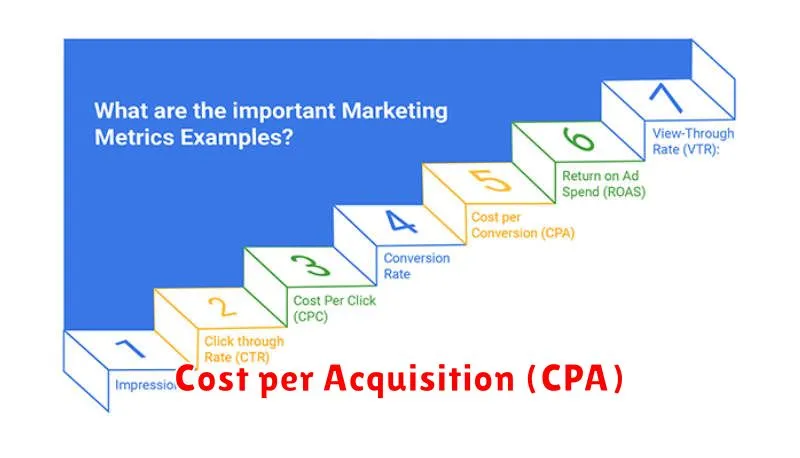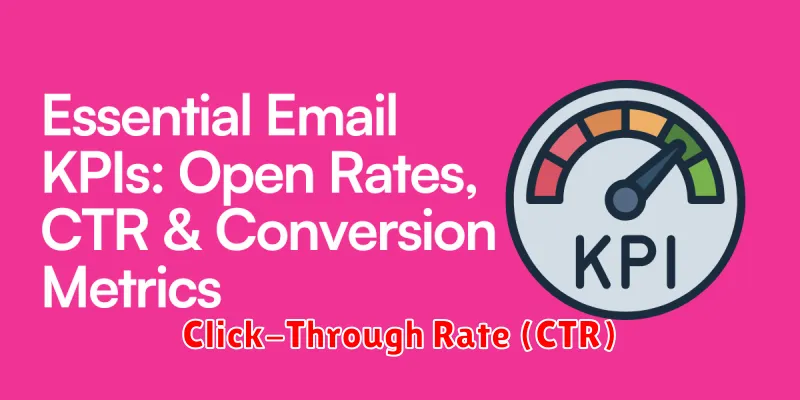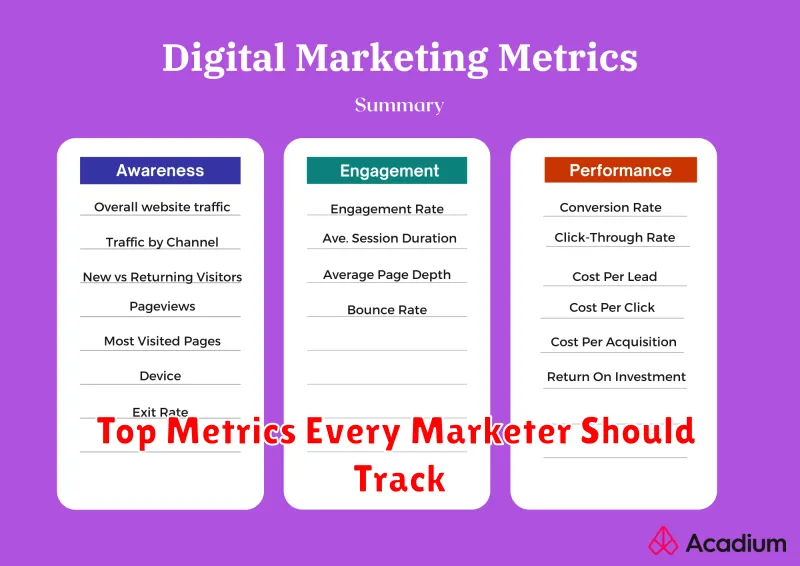In today’s dynamic market, data-driven decision-making is no longer a luxury but a necessity for marketing success. To optimize campaigns, understand customer behavior, and demonstrate return on investment (ROI), marketers need to track the right metrics. This article will explore the top metrics every marketer should be tracking, covering key performance indicators (KPIs) across various marketing channels, from website analytics and social media engagement to lead generation and customer lifetime value. By understanding these essential metrics, you can gain valuable insights into the effectiveness of your marketing strategies and identify areas for improvement.
Whether you’re focusing on brand awareness, lead nurturing, or driving conversions, tracking the right metrics is crucial. This comprehensive guide will delve into the most impactful marketing metrics, providing clear explanations of what they are, why they matter, and how to measure them effectively. From click-through rates (CTR) and conversion rates to customer acquisition cost (CAC) and customer churn rate, we’ll cover the essential KPIs that will empower you to make data-backed decisions and achieve your marketing objectives.
Traffic and Impressions
Traffic and impressions are foundational metrics for understanding audience reach and engagement. Traffic refers to the number of users visiting your website or platform. Analyzing traffic sources helps determine which marketing channels are most effective in driving visitors.
Different types of traffic exist, each offering valuable insights. Unique visitors represent the number of individual users, while returning visitors highlight audience loyalty and engagement. Page views track the total number of pages viewed, indicating content consumption. Understanding these nuances provides a comprehensive view of website activity.
Impressions, on the other hand, measure the number of times your content is displayed, regardless of clicks or engagement. This is particularly relevant for display advertising and social media campaigns. A high impression count suggests broad visibility, but doesn’t necessarily equate to actual engagement.
Monitoring both traffic and impressions is essential. Tracking traffic helps identify successful content strategies and optimize marketing efforts. Analyzing impressions helps gauge brand visibility and campaign reach.
Conversion Rate Optimization
Conversion Rate Optimization (CRO) is the systematic process of increasing the percentage of website visitors who complete a desired action – a conversion. This action could be anything from making a purchase, signing up for a newsletter, or filling out a contact form. Monitoring and improving your conversion rate is crucial for maximizing the return on your marketing investments.
A low conversion rate suggests potential issues within the user experience or marketing funnel. Are your calls-to-action clear and compelling? Is your website navigation intuitive? Is your value proposition effectively communicated? CRO involves analyzing these elements and conducting A/B testing to determine what resonates best with your target audience.
Several key metrics contribute to understanding your overall conversion rate. These can include:
- Micro-conversions: These are smaller steps a user takes toward the ultimate conversion goal, such as adding an item to their cart or creating an account.
- Macro-conversions: This refers to the primary conversion goal, like completing a purchase.
By tracking these metrics and implementing data-driven changes, you can significantly improve the effectiveness of your marketing campaigns and drive more valuable actions from your audience.
Cost per Acquisition (CPA)

Cost per Acquisition (CPA) is a crucial metric that measures the total cost of acquiring a new customer. Understanding your CPA helps you evaluate the effectiveness and profitability of your marketing campaigns.
Calculating CPA involves dividing the total cost of a specific campaign by the number of customers acquired through that campaign. For example, if a campaign costs $1,000 and results in 50 new customers, the CPA is $20.
Monitoring CPA allows marketers to:
- Optimize budget allocation: By understanding which campaigns yield the lowest CPA, marketers can allocate budget more efficiently towards high-performing channels.
- Improve return on investment (ROI): Lowering CPA directly contributes to a higher ROI on marketing spend.
- Evaluate campaign effectiveness: Comparing CPA across different campaigns provides insights into which strategies are most effective in acquiring customers at a reasonable cost.
Factors impacting CPA can include industry benchmarks, target audience, campaign complexity, and chosen marketing channels. Regularly analyzing CPA helps businesses make data-driven decisions to refine marketing strategies and achieve sustainable growth.
Customer Lifetime Value (CLV)
Customer Lifetime Value (CLV) represents the total revenue a business can reasonably expect from a single customer throughout their entire relationship. Understanding CLV is crucial for making informed decisions about sales, marketing, product development, and customer support.
By calculating CLV, businesses can identify their most valuable customer segments and tailor their strategies accordingly. This metric helps justify marketing spend and demonstrates the long-term impact of acquiring and retaining customers.
A higher CLV indicates strong customer relationships and effective business practices. Increasing CLV can be achieved through various strategies, such as:
- Improving customer retention
- Increasing average order value
- Developing customer loyalty programs
- Personalizing the customer experience
Tracking CLV provides valuable insight into the overall health and sustainability of a business. It allows marketers to optimize campaigns and allocate resources effectively to maximize profitability over the long term.
Click-Through Rate (CTR)

Click-through rate (CTR) measures how often people click on a link or call to action after seeing it. It’s a crucial metric for evaluating the effectiveness of your marketing campaigns, especially in digital channels like email and paid advertising.
CTR is calculated by dividing the number of clicks by the number of impressions. For example, if an ad receives 1,000 impressions and 50 clicks, the CTR is 5%.
A high CTR indicates that your messaging is resonating with your target audience and that your calls to action are compelling. A low CTR, conversely, suggests that you may need to refine your messaging, targeting, or call to action.
Analyzing CTR alongside other metrics provides a more comprehensive understanding of campaign performance. For instance, a high CTR with a low conversion rate might indicate a problem with the landing page experience.
Factors Affecting CTR
- Ad placement: Where your ad appears can significantly influence its visibility and click-through rate.
- Keywords: Using relevant keywords in your ads helps attract the right audience.
- Ad copy: Compelling and concise ad copy can entice users to click.
- Visuals: Eye-catching visuals can grab attention and improve CTR.
ROI on Campaign Spend
Return on Investment (ROI) is arguably the most critical metric for evaluating marketing campaign effectiveness. It measures the profitability of your marketing efforts by comparing the revenue generated against the cost of the campaign.
Calculating ROI involves a straightforward formula: (Revenue – Cost of Campaign) / Cost of Campaign. A positive ROI indicates that the campaign is generating profit, while a negative ROI signifies a loss.
Tracking ROI allows marketers to make data-driven decisions regarding budget allocation, campaign optimization, and overall marketing strategy. By understanding which campaigns deliver the highest ROI, marketers can prioritize and scale successful initiatives while phasing out underperforming ones.
Factors influencing ROI can include targeting accuracy, ad creative effectiveness, landing page conversion rates, and overall market conditions. Continuous monitoring and analysis of these factors are essential for maximizing campaign ROI.

